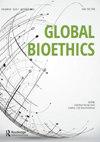Why a journal on ‘global bioethics’?
Q1 Arts and Humanities
引用次数: 0
Abstract
In order to survive, every human individual on average requires 2,000 Kcal per day for the acquisition of the 3F: Food, Fuel and Fiber. From the origins of the human phylum (which came about through the centric fusion of two chromosomes 6–5 million years ago) to the Lower Pleistocene (2 million years ago), hunting and gathering activities in savannah environments had to cater for the subsistence of no more than 500 thousand individuals in the Earth’s ecosystem. It was during the “aquatic phase” of human evolution in Eastern Africa, around 1–2 million years ago, that our ancestors underwent considerable physical alterations (loss of fur, more streamlined bodies with subcutaneous fat, the development of the cartilaginous portion of the nose, differentiation in the facial hair of men and women, breasts in women, voluntary breath control and language, and cerebral increase from 800 to 1500 c.c.) with increased manual dexterity resulting in the production of tools. These were important triggers which boosted the survival of Hominids, leading to significant population growth and diffusion throughout the various continents. However, it was the innovations related to the discovery of agriculture, 8–6 thousand years BC, with the domestication of animals and the establishment of stable settlements, which occurred almost simultaneously in 8 different areas of the Earth’s ecosystem, which truly boosted and sustained further population increases. Culture, as the adaptive product of the human mind to different environmental situations and the sum of all previous experience, spanning the last 2 million years, has facilitated the survival of increasing numbers of individuals. The human population has increased enormously over the past few centuries. From the time of Christ, when the population was around 250 million, it took 15 centuries (to the discovery of America) for it to double. A further 3 centuries sufficed (in 1835) for it to reach the first billion. Then, only another 100 years (1925) to reach 2 billion, leading to today’s figure of 7 billion, after less than 90 years. Nevertheless, this increase is not distributed equally throughout the Planet. In the last century, this growth has been twofold in Europe, fourfold in North America and Asia, sixfold in Oceania, sevenfold in Africa, and tenfold in Latin America. The impact of our species on the ecosystem was naturally sustainable until 8,000 BC, in other words, until the end of the Pleistocene, with less than 10 million individuals spread throughout the entire ecosystem.为什么是一本关于“全球生物伦理学”的杂志?
为了生存,每个人平均每天需要2000千卡来获取3F:食物、燃料和纤维。从人类门的起源(6-5百万年前通过两条染色体的中心融合而产生)到下更新世(2百万年前),大草原环境中的狩猎和采集活动必须满足地球生态系统中不超过50万人的生存需求。大约1-2百万年前,在东非人类进化的“水生阶段”,我们的祖先经历了相当大的身体变化(失去皮毛,更流线型的身体和皮下脂肪,鼻子软骨部分的发育,男性和女性面部毛发的分化,女性的乳房,自主呼吸控制和语言,从公元前800年到公元前1500年,随着手工灵巧程度的提高,人类的脑力得到了提高,从而产生了工具。这些都是促进原始人生存的重要因素,导致了人口的显著增长和在各大洲的扩散。然而,正是与公元前8 - 6千年农业的发现、动物的驯化和稳定定居点的建立相关的创新,几乎同时发生在地球生态系统的8个不同区域,真正推动并维持了人口的进一步增长。文化,作为人类思维对不同环境情况的适应性产物,以及过去200万年所有经验的总和,促进了越来越多的个体的生存。在过去的几个世纪里,人口急剧增加。从基督时代开始,人口大约是2.5亿,花了15个世纪(直到发现美洲)才翻了一番。又过了3个世纪(1835年),人口才达到第一个十亿。然后,只过了100年(1925年)就达到了20亿,导致今天的数字是70亿,经过不到90年的时间。然而,这种增长在整个地球上的分布并不平均。在上个世纪,这一增长在欧洲是两倍,在北美和亚洲是四倍,在大洋洲是六倍,在非洲是七倍,在拉丁美洲是十倍。人类对生态系统的影响一直持续到公元前8000年,换句话说,直到更新世末期,只有不到1000万人分布在整个生态系统中。
本文章由计算机程序翻译,如有差异,请以英文原文为准。
求助全文
约1分钟内获得全文
求助全文

 求助内容:
求助内容: 应助结果提醒方式:
应助结果提醒方式:


